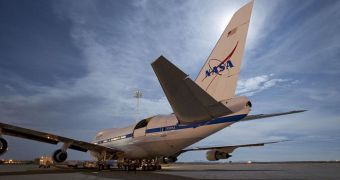A new, advanced spectrometer instrument has just been installed aboard a NASA airborne infrared telescope, and the first flight tests seeking to assess how the two platforms get along have just concluded successfully.
The events took place on Wednesday, April 6, when the Stratospheric Observatory for Infrared Astronomy (SOFIA) flew its first science mission carrying the new high-resolution, far-infrared spectrometer.
The instrument, called the German Receiver for Astronomy at Terahertz Frequencies (GREAT), was developed by German investigators from the Max Planck Institute for Radio Astronomy in Bonn.
SOFIA itself is the result of a collaboration between the American space agency and the German Aerospace Center (DLR). It is basically a large infrared reflecting telescope, housed inside the heavily modified hull of a Boeing 747SP aircraft.
The main idea behind this project is to be able to conduct scientific observations from above regular cloud covers, in regions of the Earth that provide amazing views into outer space. It so happens that some of these locations are nearly always plagued by bad weather.
As such, astronomers cannot built telescopes on the ground. In these situations, SOFIA is the next best thing, as it can fly well above the cloud cover, and image the intended target from the stratosphere.
With the addition of GREAT, the telescope is now more complex than ever before. The sheer amount of innovation that was needed to make it work is staggering in itself, but the new instrument will boost capabilities even further.
The spectrometer is a critically-important part of most telescopes. Its role is to split light picked up by the photodetectors into the wavelengths it's made up of. Each of these components is indicative of a certain substance, and so spectrometers can be easily used for chemical analysis in space.
“SOFIA’s onboard crew seamlessly combined scientists, engineers and technicians from the US and Germany, working together on an observatory developed in the US, using a telescope and instrument built in Germany, to gather data of great interest to the entire world’s scientific community,” Bob Meyer says.
He holds an appointment as the SOFIA program manager, and is based at the NASA Dryden Flight Research Center, in Edwards, California, Space Fellowship reports.
“These first spectra are the reward for the many years of work creating this technology, and underline the scientific potential of airborne far-infrared spectroscopy,” concludes the principal investigator of GREAT, Rolf Guesten.

 14 DAY TRIAL //
14 DAY TRIAL //